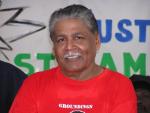By Raffique Shah
October 03, 2023
PART 2
 Ramdwar (Dennis) shouted, “Gas!”
Ramdwar (Dennis) shouted, “Gas!”
Gas, meaning CS: Crowd Dispersal Gas commonly known as “tear gas”.
The police wasted no time. It was like the proverbial “dog whistle”. Every “ranker”, Randy Burroughs and his “Flying” squad were there, as well as a large contingent of recruits, pounced on the peaceful workers and farmers raining blows with riot staffs, which were thick and heavy. Many bones were fractured on that day.
Scores of people ended up in San Fernando Hospital, which went into emergency mode.
Winston Lennard was with a small group of farmers from my union. He opted for the rear rank where Burroughs had strategically planted his squad. Lennard was beaten senseless. As a result of that, he spent several days in hospital.
Roughly 80 people or so were hospitalised, including John Humphrey, who was caught in Savonetta whilst walking by himself. Besides beating him, an officer “hunched” him with the riot baton in his stomach, rupturing an intestine, the scar of which he carries to this day.
Meanwhile, back at the leadership level, we had planned as best as we could for any eventuality. We expected the police to use some force, but never the brutality meted out to those peacefully breaking what is a questionable law.
In our briefing for handling the battered marchers, I, being the youngest and nimblest of the leaders, was asked to disappear and re-appear wherever and whenever I chose. Accompanied by an oil worker named Edwards who decided to stick with me and protect me, we made our way to an unoccupied farm-house in Carlsen Field. That kept Burroughs busy.
He raided the houses of ex-soldiers from way up North Trinidad, causing one of them, David Manmohan, to roar with laughter while exclaiming to Burroughs, as the police were searching a chest of drawers and wardrobe, “Shah cyah fit in dat!”
My personal escapades aside, that period, when I triggered the unrest by getting cane farmers to refuse to cut their produce and supply the factories, with Basdeo Panday following suit some weeks later with the sugar workers, and George Weekes and his “Rebels” turning up the heat in the oil sector, Dr Eric Williams, in my view, made blunder after blunder.
Take, for example, in the run-up to the mass meeting at Skinner Park on February 18, 1975, the PM used his authority to order the State-owned local electronic media to not carry the voice or image of one Raffique Shah. Many journalists, some of them senior and prominent, resisted the order. After all, if I was news, I was news.
The chairman of the State station’s board was an unassuming George Lushington Bowen, making the news for Eric’s sins. Poor fella, he went to the bank the day after issuing the order and rather unfortunately collapsed in the queue and died. Everybody who knew me now feared me more than they did Papa Neezar. I had gone to Moruga on one of those critical days—to look after and mobilise cane farmers, not to “wuk Obeah” to kill poor Bowen, whom I knew only by name. That created a stir since it made front-page news.
Unfazed and seemingly unafraid of “spirit lash”, Eric named right-wing crusader James Alva Bain as the new chairman. “Rock-jaw” Bane, promptly called a press conference to tell the world that not only did he agree with his predecessor that Shah’s image is banned, but those of Basdeo Panday and George Weekes as well.
Jimmy Bain was a quarrelsome fella. Somewhere in that melee in the media, senior journalists who decided to stand by the tenets of their profession ended up as victims of politicians who wanted to control the media.
Owen Baptiste’s hurriedly put-together book, Crisis, tells the much longer story of how the events in that period led to a realignment of forces.
The mass media, big business, trade unionists, and ordinary journalists all of whom had their integrity come under serious scrutiny by the population, were all involved in that imbroglio. Bear in mind, this was a mere five years after 1970.
And, although Makandal Daaga did not star or feature prominently, it was definitely a by-product, indeed a consequence of events, a continuance even, of the Black Power Movement. But I’d rather readers source the book Crisis, read all the interviews it contains, the stories it tells, and the still untold stories from that tumultuous period.
Royards Publishing House is planning to add my mutiny story to other biographies it has already published. In my case, I’ve taken 50-odd years before finally deciding to put pen to paper and write the true story of the 1970 mutiny. I’ve hastened my recollection because of the number of “Nansi” stories currently in circulation. Stories by men who couldn’t even be heroes in their homes, far less on the battlefield.
